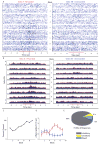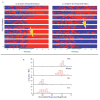Need for related multipronged approaches to understand olfactory bulb signal processing
- PMID: 19686151
- PMCID: PMC2859900
- DOI: 10.1111/j.1749-6632.2009.04375.x
Need for related multipronged approaches to understand olfactory bulb signal processing
Abstract
Recent work from our laboratory in awake behaving animals shows that olfactory bulb processing changes depending profoundly on behavioral context. Thus, we find that when recording from the olfactory bulb in a mouse during a go-no go association learning task, it is not unusual to find a mitral cell that initially does not respond to the rewarded or unrewarded odors but develops a differential response to the stimuli during the learning session. This places a challenge on how to approach understanding of olfactory bulb processing, because neural interactions differ depending on the status of the animal. Here we address the question of how the different approaches to study olfactory bulb neuron responses, including studies in anesthetized and unanesthetized animals in vivo and recordings in slices, complement each other. We conclude that more critical understanding of the relationship between the measurements in the different preparations is necessary for future advances in the understanding of olfactory bulb processing of odor information.
Figures


Similar articles
-
Task-Demand-Dependent Neural Representation of Odor Information in the Olfactory Bulb and Posterior Piriform Cortex.J Neurosci. 2019 Dec 11;39(50):10002-10018. doi: 10.1523/JNEUROSCI.1234-19.2019. Epub 2019 Oct 31. J Neurosci. 2019. PMID: 31672791 Free PMC article.
-
Leptin modulates olfactory discrimination and neural activity in the olfactory bulb.Acta Physiol (Oxf). 2019 Oct;227(2):e13319. doi: 10.1111/apha.13319. Epub 2019 Jun 18. Acta Physiol (Oxf). 2019. PMID: 31144469
-
Coding odor identity and odor value in awake rodents.Prog Brain Res. 2014;208:205-22. doi: 10.1016/B978-0-444-63350-7.00008-5. Prog Brain Res. 2014. PMID: 24767484 Free PMC article. Review.
-
Parallel odor processing by two anatomically distinct olfactory bulb target structures.PLoS One. 2012;7(4):e34926. doi: 10.1371/journal.pone.0034926. Epub 2012 Apr 4. PLoS One. 2012. PMID: 22496877 Free PMC article.
-
Complex neural representation of odour information in the olfactory bulb.Acta Physiol (Oxf). 2020 Jan;228(1):e13333. doi: 10.1111/apha.13333. Epub 2019 Jul 2. Acta Physiol (Oxf). 2020. PMID: 31188539 Free PMC article. Review.
References
-
- Buck L, Axel R. A novel multigene family may encode odorant receptors: a molecular basis for odor recognition. Cell. 1991;65:175–187. - PubMed
-
- Buck LB. Information coding in the vertebrate olfactory system Annu. Rev Neurosci. 1996;19:517–544. - PubMed
-
- Malnic B, Hirono J, Sato T, Buck LB. Combinatorial receptor codes for odors. Cell. 1999;96:713–723. - PubMed
-
- Mori K, Takahashi YK, Igarashi KM, Yamaguchi M. Maps of odorant molecular features in the Mammalian olfactory bulb Physiol. Rev. 2006;86:409–433. - PubMed
MeSH terms
Grants and funding
LinkOut - more resources
Full Text Sources

